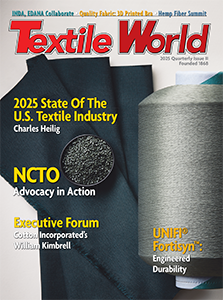ATLANTA — March 14, 2016 — The start of 2016 has proved to be full of new technologies and innovations in the technical textile industry. Techtextil North America, held May 3-5, 2016, at the Georgia World Congress Center in Atlanta is to host more than 30 hand-selected industry experts from around the world that plan to reveal advanced technologies at the premier symposium held concurrently with the show floor.
Techtextil North America is co-located with Texprocess Americas and JEC Americas. The trifecta of these shows brings together the full spectrum of technical textiles, nonwovens, sewn products and equipment, technology and composites into one central location.
During the three day technical textile event visitors are able participate in 10 hot topic sessions plus two bonus sessions put on by IAF and a joint session hosted by Techtextil North America, Texprocess Americas and JEC Americas. Visitors can expect to connect with potential new partners, learn about exciting new technologies and discover how they can grow their business while partaking in the Techtextil North America Symposium.
Highlights of the highly acclaimed Symposium Include:
Tension Structures
Learn more about the architectural perspective of a tension structure and what to know about tension structures from an architectural point- of-view. The session will then turn to an engineering perspective and what to expect from a tension structure in relationship to engineering loads and what it takes to erect a tension structure and have it be safe and last based on the lifetime of the fabric selected. The session will then add a fabrication perspective and what is involved with the fabrication of a tension structure from a fabricators perspective and what it takes to work with a client within all of these different aspects.
Textile Testing and How It Affects the Industry
Textile Testing plays a major role in the development of new products, as well as maintaining quality standards of existing products. This session focuses on how testing affects the textile industry.
Advancements in Nonwovens
The nonwovens session will focus on the latest machinery developments and all segments of the industry from web formation to bonding including needle punching, spunbonding and melt blowing to hydroentangling, and thermal bonding. New and emerging product lines will also be a focus.
New Fiber Technologies (Basic)
(2-Part Session)
Part One is intended for those new to the synthetic fiber industry, those needing a good understanding of fiber fundamentals, and those interested in learning about the latest commercially significant fiber processes. This session will take you through the basic fiber technologies and respective markets currently using these respective fibers and what new horizons are being explored within each of these areas. If you are looking for a refresher course outside of your area of expertise or new to the business as discussed this course is for you.
New Fiber Technologies (Advanced)
(2-Part Session)
In Part 2 of this session learn from experts about the most recent synthetic fiber developments expected to have technical and commercial significance in the field of synthetic fibers. Advanced products from micro, nanofibers to carbon fibers will be discussed.
Advancements and Future Uses Smart Textiles
Discover advancements and future expectations in smart, functional and innovative textiles. An introduction to new functions and unique structures of textiles suitable for many challenging applications related to engineering and medical applications.
Auxetic and Protective Textiles
Auxetic structures and materials are those that get fatter on stretching rather than becoming thinner, as is the ordinary case. This counterintuitive behavior opens exciting vistas for design and creation of new textile materials and structures for applications that would benefit from auxetic response to tension or compression. This session will highlight advances in such auxetic textile materials and structures. Some of the presentations will couple auxetic behavior with protective functions for personnel exposed to a dangerous environment or situation. Included in this session will also be presentations on non- auxetic protective textiles.
Innovations in Geosynthetic Textiles
Geosynthetics are being utilized for a variety of construction applications that were once thought to be only in the realm of Concrete or Steel, allowing for construction of structures in extreme conditions such as very soft soils, in underwater locations and in contaminated or extreme pH conditions to name a few. This session will feature presentations on new and innovative Geosynthetic textile technologies for Geotechnical and Civil Engineering applications.
Welding
Stitch-free seam technology — welded or bonded — are two different concepts. Welding is the process of joining pieces of synthetic fabrics with various methods: hot air, hot wedge, RF, ultra-sonic, plunge, laser, and impact. Bonding, on the other hand, can be performed on two pieces of fabric by placing a heat activated material (adhesive) between them. Stitch-free seaming technologies are extensively used in performance apparel, sportswear, and fitted active wear. Technical outerwear is becoming less bulky and more form-fitting while retaining the latest advances in waterproof and breathable capability.
Sustainability / How does sustainability aid the textile industry?
Many companies in the textile industry have embarked on a path toward sustainability. This session focuses on sustainability champions sharing their thoughts on emerging technologies, latest trends and the future efforts of maintaining some degree of sustainability while running a profitable enterprise.
This year visitors who purchase a symposium pass are able to choose two complimentary bonus sessions.
How Technology Is Implemented Across the Globe to Increase Productivity in the Apparel Industry: Developed by IAF
Connecting Technical Textiles and Composites: Developed by Techtextil North Americas, Texprocess Americas and JEC Americas
The 2016 Symposium has been developed by leading industry experts to provide a platform for presenters to interact with attendees after each session.
Advisory Council Board Members:
- Dr. Behnam Pourdeyhimi, The Nonwovens Institute
- Mike Clements, Huesker Inc.
- Sam Buff, Gaston College
- Bipin Kumar, UC Davis
- Marc Shellshear, Gale Pacific Inc.
- Dr. Andy Griffin, Professor Emeritus Georgia Institute of Technology
Posted March 14, 2016
Source: Techtextil North America




